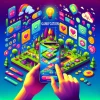
In a world where our smartphones have become extensions of ourselves, health apps are increasingly playing a pivotal role in managing personal wellbeing. Yet, despite their potential, many users abandon these apps shortly after downloading them. Enter gamification—a dynamic strategy that can transform mundane health tasks into engaging and rewarding experiences. This article delves into how gamification can boost health app engagement, turning daily health routines into enjoyable journeys.
Understanding Gamification: Not Just Fun and Games
Gamification is the process of applying game-design elements in non-game contexts. It's not merely about making something fun; it's about using the principles of games to motivate users and enhance their experience. Think of it as adding a layer of excitement to routine activities. For instance, a fitness app might use points, badges, and leaderboards to encourage users to exercise regularly, transforming a solitary workout into a communal competition.
Real-World Examples: Success Stories in Health Apps
Several health apps have successfully incorporated gamification to engage users. Take 'Zombies, Run!', an app that turns running into a game where users complete missions and escape from virtual zombies. This creative approach has motivated many to lace up their running shoes more often. Another example is 'MyFitnessPal', which uses streaks and reminders to encourage consistent food logging. These strategies make users feel a sense of accomplishment and continuity, crucial for maintaining long-term engagement.
The Psychology Behind Gamification: Why It Works
At its core, gamification taps into fundamental human psychology. It leverages our intrinsic desire for achievement, competition, and social interaction. When users achieve a new level or earn a badge, they experience a dopamine rush, similar to completing a challenging task. This reward system keeps users coming back, as they are driven by the anticipation of the next reward. Moreover, social elements like leaderboards satisfy our competitive instincts, pushing us to outperform our peers.
Common Pitfalls: Avoiding Gamification Mistakes
While gamification can significantly enhance engagement, it's crucial to avoid common mistakes.
1) Over-gamification: Adding too many game elements can overwhelm users. It's important to strike a balance.
2) Lack of meaningful rewards: If the rewards don't resonate with users, the gamification effort will fall flat.
3) Ignoring user feedback: Continuous improvement is key. Ignoring what users say can lead to disengagement. Being mindful of these pitfalls can ensure that gamification strategies remain effective and user-centric.
Practical Tips: Implementing Gamification in Health Apps
To effectively implement gamification, developers should start by understanding their audience. What motivates them? 1) Setting achievable goals: Break down tasks into smaller, attainable goals to keep users motivated.
2) Incorporating social features: Encourage users to share achievements and challenge friends.
3) Providing real-world rewards: Partner with brands to offer discounts or freebies as incentives. By focusing on these strategies, health apps can create a more engaging user experience.
The Future of Health Apps: Gamification and Beyond
As technology evolves, the potential for gamification in health apps continues to grow. With advancements in AI and machine learning, future health apps could offer even more personalized gamification experiences. Imagine an app that adapitates difficulty levels based on your progress or one that offers real-time feedback during workouts. The possibilities are endless, and the ultimate goal remains the same: to keep users engaged and committed to their health goals.































